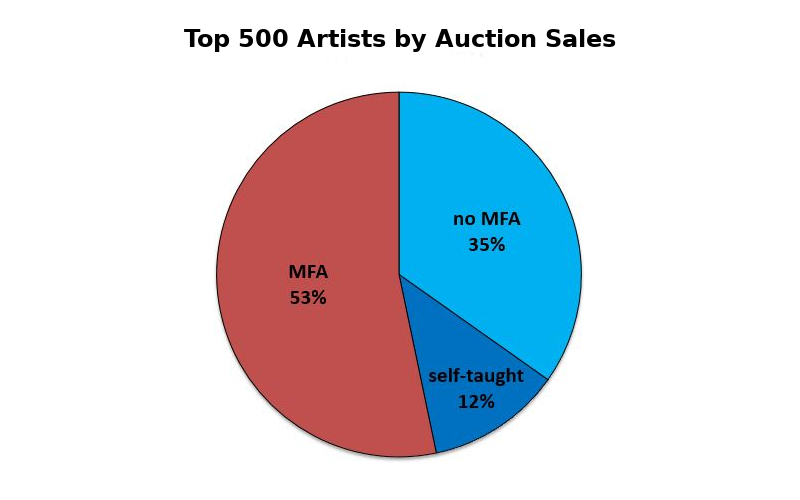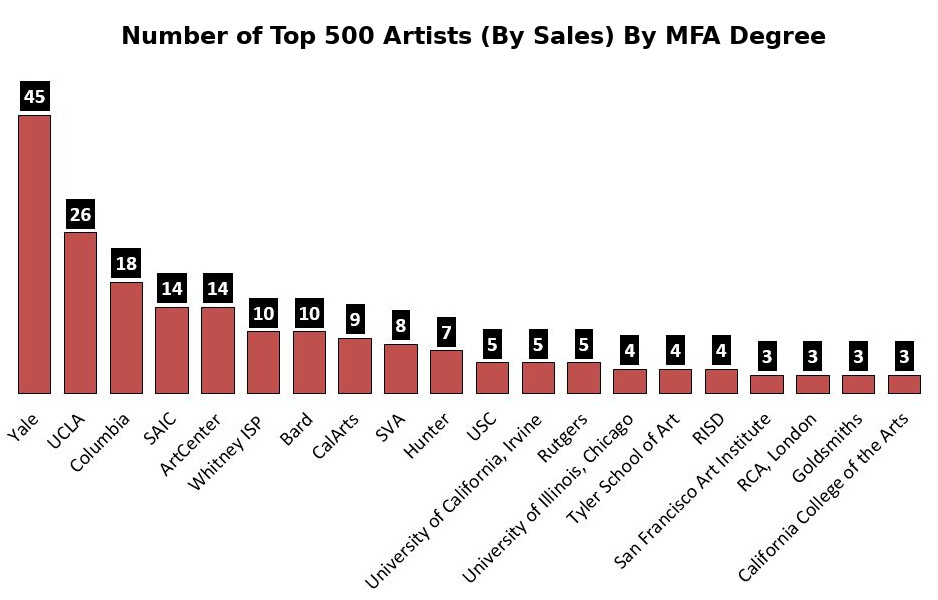The Truly Free, Open Source MFA

Everyone loves to talk shit about MFAs, but what’s the good free option for people who want the MFA experience but are unable or unwilling to pay for it?
Work in Progress: updated April 16th 2020
The art world consensus seems to be that MFA programs are overpriced and borderline predatory, but there’s also a lot of evidence that getting an MFA is key to “making it” as an artist or arts professional.
Even if you don’t care about making it as an arts professional, there are still plenty of reasons why you might want the MFA experience: because you enjoy making art and want feedback, because you like learning about art and want to learn faster, because you want to make friends who care about art. Overall, the experience of getting an MFA seems pretty great except for the fact that it’s super expensive and competitive and therefore super stressful.
So, what are the good free or cheap MFA options? From what I’ve read, if one carefully put together a CV and applied for scholarships, one might be able to get a free or cheap ride at Hunter College or UCLA. I’m sure there are other good options out there. But getting on the institutional MFA track poses three problems for me: 1) there’s a chicken and egg problem of needing to build a quality portfolio, while being employed full time, without the skills and connections needed to build a portfolio that an MFA is supposed to provide, 2) space is limited, so there’s a good chance I wouldn’t even get admitted, 3) these institutions are far from where I live, and are now closed indefinitely.

Given all the above factors, I think my best option is some sort of non-official, self-administered MFA experience. If you care more about mastery than a credential, a non-institutional MFA might even be better in the long run.
The two main problems with self-administering an MFA experience I can think of are: how do you teach yourself the stuff you don’t know you don’t know, and how do you meet the people you don’t know you need to know? In an institutional context, these problems are solved by the academic departments and the admissions department, respectively. We’ll have to do our best to replicate their functions.
Successfully self-administering something like this definitely has some prerequisites, please see the footnote. Working through this sort of program as a group would likely make things easier and more fun, please email or DM me if you want to link and build.
I) Readings
I think that roughly two-thirds the reading done should be “assigned” from existing curriculums from institutional programs you admire. For example, there’s a number of artists and critics I admire who went through the Whitney ISP, so I borrowed a friend’s old Whitney ISP syllabus, now I’m slowly working my way through the readings. I think the other one-third of reading should be “free reading” of books and academic articles that seem interesting to you personally.
My current idea of the number of readings required to achieve MFA-like mastery:
Sixty selections / articles self-assigned from syllabi
Example from Whitney ISP 2014:
Kracauer, Siegfried. The Mass Ornament. Harvard University Press, 1995. Pp. 49-62.Twenty selections / articles of “free reading”
Fifteen books (or books totaling ~4,500 pages) assigned from syllabi
Five books (or books totaling ~1,500) of “free reading”
Note: Will update later with sources for syllabi and texts, unfortunately most universities don’t make syllabi public, though there are some exceptions.
II) Discussion
Of course, just reading stuff is not enough. You’ve got to write or talk about what you’re reading. This is harder to do without an institution, but not impossible. I think the avenues for discussion need to fit the personality of the MFA student. Here’s the avenues I’ve identified for myself:
Publish at least seven blog posts / articles.
I think the caveat here is that these articles must be published in places you actually read yourself, or where you’ll actually get feedback. Editors will hopefully prevent you from publishing something you’ll regret later. Hopefully doing the type of reading outlined above will give you some ideas for what to write about. These blog posts and articles replace the essays you’d be assigned to write by MFA instructors.
Will update with some good publications and blogs.
Shitpost at least once a week on Instagram / Twitter / Facebook / etc.
Before quarantine, a lot of art world discourse was happening on social media, and now I’d imagine it’s the primary place for discourse. It’s hard to get into the habit of shitposting (i.e. posting your thoughts on things more or less as they arise), but the wonderful thing about social media is that if your thoughts are stupid, there’s a good chance someone will correct them, for free, very directly. Shitposting, like going to parties, takes a certain amount of chutzpah, but as long as you are relatively polite and respectful you might have some fun.
Will update with some good accounts to follow.
Go to at least ten panels or workshops.
Pre-COVID, access to panels and workshops required living in a big city, but now they’re basically all on Zoom! Participating in stuff like this gives you a chance to practice your spoken International Art English, if you want to.
Will update with some organizations that host this sort of thing.
Join a reading group or book club.
This one is probably the trickiest to figure out, reading groups are kind of the better, more chill version of panels and workshops. I’ve been lucky to find two reading groups I like, but I think to some degree you need to gel with the group for things to work out.
III) Museums / Galleries
Going to look at good physical art is obviously really important, and if you just do readings and talk about art you can get lost in the sauce.
Unfortunately, right now museums and galleries are closed indefinitely, but I’ll outline an approach for going to IRL museums and galleries in a fun and educational way:
Assuming you live in a place with good art museum(s), spend more time at museums than galleries.
Museums are a glacier of learning. A lot of “second tier” / rust belt cities in the US have really good museums, legacies of their past glory. These museums often have free entry and are almost empty. In places like NYC, your best bet for free and pleasant museum visits is getting or making a press pass. If you’re doing the “writing articles and blog posts” step outlined above, you can probably pull this off. If you can only go to the museum when it’s really crowded, I recommend a bit of exercise / drugs beforehand so you can be in a little safe space bubble. I think twenty museum visits is a minimum, doesn’t need to all be different museums.
For galleries, go with friends, or if you don’t have friends, use Seesaw and Artguide to figure out what shows to go to.
(Disclosure: Computer Lab maintains the Artguide app.) Try to make visiting galleries a regular part of your social life, if possible. I don’t think there’s a really a quota here.
IV) Work
Assuming you’re making work to some degree already, the problems for a self-administering MFA student is 1) pressuring yourself to do more and/or better work, and 2) getting good feedback. If you can figure out how to do 1) and 2) without institutional support, it’s probably even better than having gone through an official MFA program.
I think the best way to solve this problem is through collaboration, consultation, or apprentice-style work with artists or art organizations you admire. Figure out what skills, resources, and connections you have, and offer them to people doing the type of work you want to do. If you can, ask for money or other compensation. When someone is paying you, or you’re contributing to a project they care about, they will be more likely tell you when you’re doing a bad job (or a good job).
In my limited experience doing this sort of collaborative project, I’ve picked up a lot of tacit knowledge from good artists, and hopefully helped make cool things happen. If and when these projects “ship” to the public, you may also get real feedback from critics or the public. Or your work might be ignored, which is also a type of valuable feedback that you might not get in an institutional MFA program.
I think to achieve “mastery”, you probably need to “ship” at least three projects to the public, projects you feel represent some big chunk of your maturing creative vision, and do at least ten smaller, possibly private projects to build up to to these big public projects.
Footnote: Prerequisites and Caveats
Successfully completing the program above obviously requires lots of life skills, social grease, liberal arts knowledge, free time, and possibly also physical space and tools. Therefore, I’d say that this MFA probably requires at least an undergrad degree or equivalent life experience. But there’s nothing stopping a broke teenage dropout from trying.
Finally, the designer of this curriculum doesn’t have an real MFA or BFA, and is only about 15% through the curriculum he’s designed for himself. If you see things that are missing, inadequate, or overambitious, please tell me.